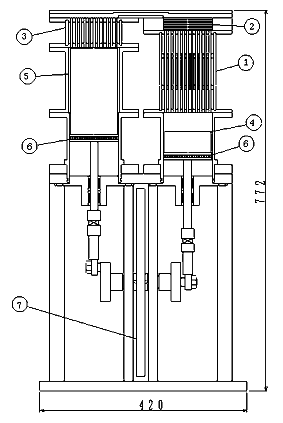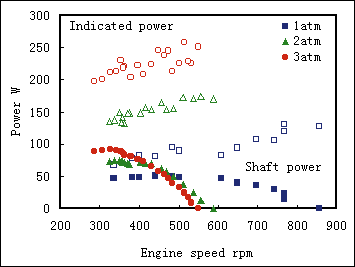
 Japanese
Japanese

 Purpose of developing
Purpose of developing
 Structure and specification of Stirling engine for using exhaust gas
Structure and specification of Stirling engine for using exhaust gas

| 1 | Heater |
|---|---|
| 2 | Regenerator |
| 3 | Cooler |
| 4 | Expansion side piston |
| 5 | Compression side piston |
| 6 | Piston ring |
| 7 | Flywheel |
| Structure | Material | |
| Heater | Double piping | Stainless |
| Regenerator | 50 mesh wire net | Brass |
| Cooler | Shell and tube | Brass |
Figure shows Stirling engine designed and made by our laboratory. There specifications are given on table.
The exhaust pipe of gasoline engine is connected the heater of Stirling engine by flexible pipe which covers minimum distance between two engines. The connecting pipe and the heater are protected by insulator against heat radiation.
For the heater of the heat exchanger, double piping design is opted in order to recover the maximum heat capacity of exhaust gas. With this design, working gas of Stirling engine passes inside pipe, while exhaust gas flows outside. The material of tube is used Stainless for inhibiting oxidation.
For the regenerator, its material is brass, can be maximally included 60 sheets of 50 mesh. The cooler is adopted by shell and tube, in order to improve thermal conductivity, tube material is brass. Cooling way is compulsory cooled by water.
As for gasoline engine, a small general purpose 4 cycle engine is used to obtain exhaust gas. Gasoline engine has maximum power 8.5ps.
 Performance of Stirling engine for using exhaust gas
Performance of Stirling engine for using exhaust gasTable shows experiment conditions which we carried out until now.
| Effect of heat capacity with exhaust gas | Non-load:800WÅA40%load:3.5kW |
|---|---|
| Effect of regenerator number | 20,40,60sheets |
| Effect of buffer pressure | 1,2,3atm |
 Effect of heat capacity with exhaust gas
Effect of heat capacity with exhaust gas
Heat capacity with exhaust gas is calculated by quantity of air in gasoline engine, rate of fuel consumption, exit temperature of exhaust gas. For non-load, heat capacity with exhaust gas is 800W, then gasoline engine speed is 3000rpm, exit temperature of exhaust gas is 650Åé. Similarly, for 40%load, each specifications have 3.5kW, 2000rpm, 600Åé.This heat capacity is calculated from exit temperature to atmosphere temperature.
 Effect of regenerator number
Effect of regenerator number
We carried out experiment to change regenerator number of wire net, 20, 40, 60sheets.In this experiment, gasoline engine was operated 40%load(3.5kW), Stirling engine was operated under stroke 60mm.
 Effect of buffer pressure
Effect of buffer pressure
We carried out experiment to change buffer pressure, 1, 2, 3atm.In this experiment, gasoline engine was operated 40%load(3.5kW). Stirling engine was operated under stroke of 60mm, regenerator number of 60sheets.
 Right figure shows the performance of Stirling engine for effect of buffer pressure. In this figure, maximum shaft power was recorded 91.5W under 320rpm.A number 3% in heat capacity of exhaust gas can be recovered by Stirling engine as effective power. In the future, it is expected that recovery percentage fairly improves if number of Stirling engine can be increased.
Right figure shows the performance of Stirling engine for effect of buffer pressure. In this figure, maximum shaft power was recorded 91.5W under 320rpm.A number 3% in heat capacity of exhaust gas can be recovered by Stirling engine as effective power. In the future, it is expected that recovery percentage fairly improves if number of Stirling engine can be increased.
 Return to Stirling Engines of Saitama University
Return to Stirling Engines of Saitama University
 Return to Stirling Engiene Home Page Academic Edition
Return to Stirling Engiene Home Page Academic Edition